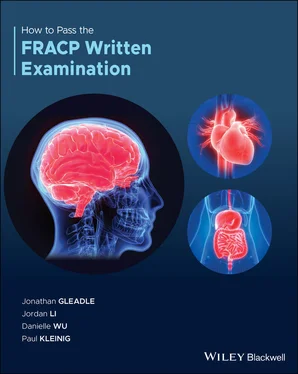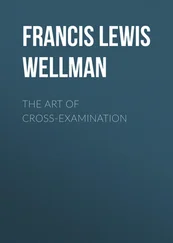Overall the fairly significant medium‐term benefits of this class of drug are compelling reasons for significantly expanded use, and individual practitioners need to be aware of individual situations that pose excess risk for a patient on this class of medication. Two significant such situations are physiological stress and volume depletion, where relative insulin insufficiency and excess diuresis can lead to DKA and AKI, respectively.

Donnan J, Grandy C, Chibrikov E, Marra C, Aubrey‐Bassler K, Johnston K et al. Comparative safety of the sodium glucose co‐transporter 2 (SGLT2) inhibitors: a systematic review and meta‐analysis. BMJ Open. 2019;9(1):e022577.
https://bmjopen.bmj.com/content/9/1/e022577
26. Answer: D
The tests are most indicative of subclinical hypothyroidism, which is most likely due to autoimmune (Hashimoto) thyroiditis. Randomised trial data suggests that treatment of subclinical hypothyroidism is not warranted in older adults, however observational data suggests that treatment may be considered in pregnant women, or if TSH is over 7.0 mIU/L. Treatment can also be considered in younger individuals, particularly females with a possibility of becoming pregnant and patients with multiple symptoms attributable to hypothyroidism. Certainly, there is a general recommendation for treatment in individuals with TSH equal to or greater than 10.0 mIU/L. Other possible indications for treatment are thyroid peroxidase antibody positivity or presence of a goitre. Observational data also suggest that individuals with subclinical hypothyroidism have a greater prevalence of heart failure, coronary heart disease mortality and fatal stroke.
Diagnosis of subclinical hypothyroidism requires measurement of normal FT4 despite elevated TSH. As levels fluctuate for an individual, repeat measurements are required to confirm subclinical hypothyroidism or progression to hypothyroidism. For measurements of TSH between 4.5 and 14.9 mIU/L, reassessment should be conducted in 1–3 months to maximise clinical relevance. However, if the TSH is over 14.9 mIU/L, assessment should be repeated more expediently as a transition to overt hypothyroidism is more likely.
If treatment is initiated for subclinical hypothyroidism, TSH should be measured after six weeks of levothyroxine therapy in order to adjust the dosage accordingly. Annual measurements of TSH are generally sufficient thereafter.

Biondi B, Cappola A, Cooper D. Subclinical Hypothyroidism. JAMA. 2019;322(2):153.
https://jamanetwork.com/journals/jama/article-abstract/2737687
27. Answer: C
Papillary thyroid carcinoma (PTC) is the most common form of thyroid cancer, and the most common form of thyroid cancer caused by exposure to radiation. Total thyroidectomy is the mainstay of treatment in patients with PTC. Radioactive iodine ablation and long‐term TSH suppression using thyroxine are also important adjuvant therapies.
An excellent response to the initial treatment is defined by an undetectable serum thyroglobulin, the absence of both thyroglobulin antibodies and abnormal findings on neck ultrasound.
The purpose of follow‐up is for early detection and treatment of persistent or recurrent locoregional or distant PTC. Most local recurrences develop within the first 5 years after treatment. However, in a few cases, local or distant recurrence may develop within 10–20 years after the initial treatment.
Three months after initial treatment, TFTs should be done to check the adequacy of thyroxine suppressive therapy. Follow‐up at six to twelve months should ascertain whether or not the patient is free of disease. This follow‐up should include a physical examination, neck ultrasound, and a check of basal and recombinant human TSH (rhTSH)‐stimulated serum thyroglobulin measurement. At this time, about 80% of the patients will have a normal neck ultrasound, an undetectable (<1.0 ng/ml) stimulated serum thyroglobulin in the absence of serum thyroglobulin antibodies, and will be classified in the low‐risk category or in complete remission. The rate of subsequent recurrence is very low (<1.0% at 10 years). Diagnostic whole‐body bone scan does not add any clinical information in this setting and is not required.
Recently, new methods for obtaining serum thyroglobulin measurement with functional sensitivity below 0.1 ng/ml have become available. An undetectable basal serum thyroglobulin (<0.1 ng/ml) may give the same information as a stimulated thyroglobulin test, thus negating the need for thyroglobulin stimulation. However, the higher negative predictive value of these tests comes at the expense of a very low specificity, and risks exposing large numbers of patients, who are probably free of disease, to extensive testing and/or unnecessary treatment.
In clinical practice, when basal serum thyroglobulin is ≤0.1 ng/ml and neck ultrasound is unremarkable, patients may be considered free of disease (negative predictive value, NPV = 100%) and a rhTSH stimulation can be avoided. However, if basal serum thyroglobulin is between 0.1 ng/ml and 1.0 ng/ml, it is not possible to distinguish between the absence or presence of disease; rhTSH stimulation testing is then necessary.
The subsequent follow‐up of patients considered free of disease at 6–12 months should consist of physical examination, basal serum thyroglobulin measurement on thyroxine and neck ultrasound once per year.
Patients with a high risk of disease recurrence who do not respond excellently to treatment should be followed up with serum TSH, thyroglobulin and anti‐thyroglobulin antibody determination and neck ultrasound every 6–12 months.
Measurement of the serum thyroglobulin level with anti‐thyroglobulin antibodies to validate accuracy of the thyroglobulin assay is important. In the absence of residual normal thyroid tissue (after surgical and radioiodine ablation), thyroglobulin is a marker of residual or recurrent papillary or follicular thyroid carcinoma.

Lamartina L, Grani G, Durante C, Borget I, Filetti S, Schlumberger M. Follow‐up of differentiated thyroid cancer – what should (and what should not) be done. Nature Reviews Endocrinology. 2018;14(9):538–551.
https://www.nature.com/articles/s41574-018-0068-3
28. Answer: A
The vast majority of driver mutations in thyroid carcinoma come from the MAPK pathway, which dominates the oncogenesis of both papillary and follicular thyroid cancers, and together account for around 85% of thyroid cancer diagnoses. Of these mutations, alterations in BRAF V600E accounts for the majority, and less commonly RAS, NTRK, ALK, or RET. Anaplastic thyroid cancers have high mutational variation involving multiple pathways, but are rare, and associated with poor mean survival. Medullary thyroid cancers are typically associated with gain‐of‐function mutations in RET, a proto‐oncogene in the MAPK pathway.

Fagin J, Wells S. Biologic and Clinical Perspectives on Thyroid Cancer. New England Journal of Medicine. 2016;375(11):1054–1067.
Читать дальше
















